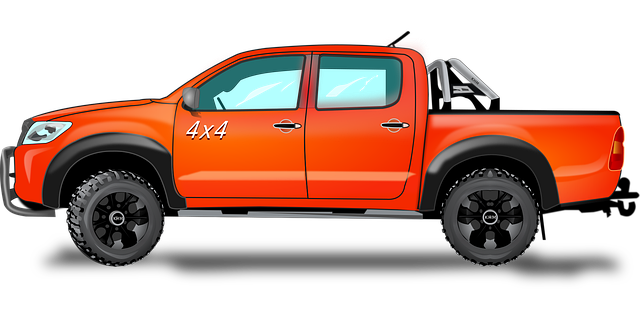4WD off-road vehicles demand rigorous pre-run inspections to ensure safety and performance on rough trails. Key checkpoints include tire condition, suspension integrity, and drivetrain health, with attention to potential wear, fluid levels, and electrical functionality. Regular maintenance is paramount for drivetrain components like driveshafts, differentials, and transfer cases, as well as addressing any fluid leaks or electrical issues that could disrupt engagement or system integrity. Mastering 4WD off-road techniques is essential; this includes understanding various 4WD modes to navigate different terrains smoothly and efficiently, ensuring optimal vehicle performance. Proactive maintenance schedules involve verifying fluid levels, tire alignment, and rotation, alongside inspecting all electrical components regularly for proper functioning. By staying vigilant with these practices, off-roaders can effectively troubleshoot issues, maintain safety, and ensure their vehicle's reliability on any landscape. Mastery of 4WD off-road techniques, combined with regular maintenance, is key to confidently navigating challenging off-road conditions and avoiding common obstacles that could disrupt travel.
4WD off-road enthusiasts know that a vehicle’s reliability is as crucial as the driver’s skill in navigating rugged terrains. This article serves as a thorough resource for pre-run inspections and troubleshooting common issues, ensuring your off-road journey is both safe and exhilarating. Mastering 4WD off-road techniques is one aspect; maintaining your vehicle to withstand the elements is another. Dive into the comprehensive guide and troubleshooting strategies necessary for a successful off-road adventure.
- Comprehensive Guide to Pre-Run Inspection of 4WD Off-Road Vehicles
- Troubleshooting Common Issues in 4WD Off-Road Systems
Comprehensive Guide to Pre-Run Inspection of 4WD Off-Road Vehicles

Before embarking on off-road trails, a thorough inspection and diagnosis of your 4WD vehicle are critical to ensure safety, performance, and durability. A pre-run check is a systematic process that involves examining all major components of the vehicle for functionality and wear. Start with the tires, ensuring they are properly inflated according to the manufacturer’s specifications for off-road conditions. Inspect tread depth and check for any damage or foreign objects embedded that could impede traction. The suspension system should be checked next; look for signs of wear, excessive play, or fluid leaks. Ensure that all bushings, mounts, and joints are secure and free from damage to maintain optimal wheel articulation over rough terrain.
Moving on to the drivetrain, verify the operation of the transfer case, differentials, and drive shafts. Pay close attention to any unusual noises or movements, which may indicate potential failures during your off-road adventure. Fluid levels and condition are paramount; replace or top up fluids as needed to maintain viscosity and protection for critical components like differentials and transmissions. Additionally, the electrical system, including lights and accessories, should be tested to ensure all components are functioning correctly. Mastering 4WD off-road techniques is not solely about skill but also about having a vehicle in top condition. By conducting a comprehensive pre-run inspection, you can confidently navigate difficult terrains with greater assurance that your vehicle will perform as expected and handle the rigorous demands of off-road driving.
Troubleshooting Common Issues in 4WD Off-Road Systems

4WD off-road systems are robust and designed to handle challenging terrains, but they can still encounter issues that require troubleshooting. When a vehicle’s four-wheel-drive system isn’t functioning as expected, it’s crucial to methodically diagnose the problem to ensure safe navigation of difficult trails. Common issues include drivetrain failures, which can be caused by worn out or damaged components such as driveshafts, differentials, and transfer cases. Regular inspections should focus on checking these parts for signs of wear or damage, ensuring that all mounting points and seals are intact to prevent fluid leaks, which can compromise the system’s performance. Another frequent problem is electrical malfunctions within the 4WD system. Connectors, switches, and wiring can corrode or become disconnected over time, leading to inconsistent engagement or failure to switch into four-wheel drive. Owners should familiarize themselves with the system’s electrical components, inspecting them for corrosion or damage and ensuring secure connections. Mastering 4WD off-road techniques also involves understanding the vehicle’s specific 4WD modes and how to effectively use them. This includes learning the best terrain for each mode and practicing smooth transitions between two-wheel and four-wheel drive to avoid stressing the system unnecessarily. By staying vigilant and proactive with maintenance, off-road enthusiasts can troubleshoot and resolve issues promptly, enhancing their safety and the reliability of their vehicle during off-road excursions. Regular upkeep includes checking all fluids, including transmission fluid, transfer case oil, and differentials, ensuring they are at appropriate levels and within the correct viscosity range for optimal performance in diverse environmental conditions. Additionally, aligning the tires and regularly rotating them can help maintain traction and prevent unexpected failures during off-road maneuvers. With a comprehensive understanding of the vehicle’s 4WD system and proactive maintenance habits, off-roaders can confidently conquer rugged terrains and avoid common pitfalls that might hinder their journey.
mastering 4WD off-road techniques is not just about understanding your vehicle’s capabilities but also ensuring its reliability through meticulous inspection and diagnosis. This article has provided a thorough guide to pre-run checks and addressed common issues that can arise in 4WD off-road systems. By following the outlined steps, enthusiasts and professionals alike can enhance their safety and performance on challenging terrains. Remember to regularly inspect and maintain your vehicle to navigate off-road environments with confidence. With these practices, you’ll be well-equipped to conquer the trails and tackle the elements that make off-road driving an exhilarating pursuit.
